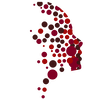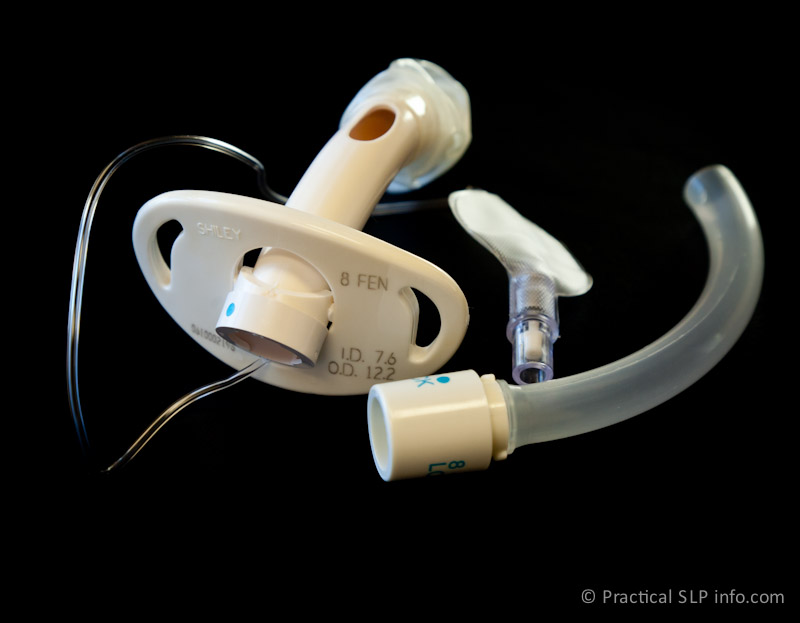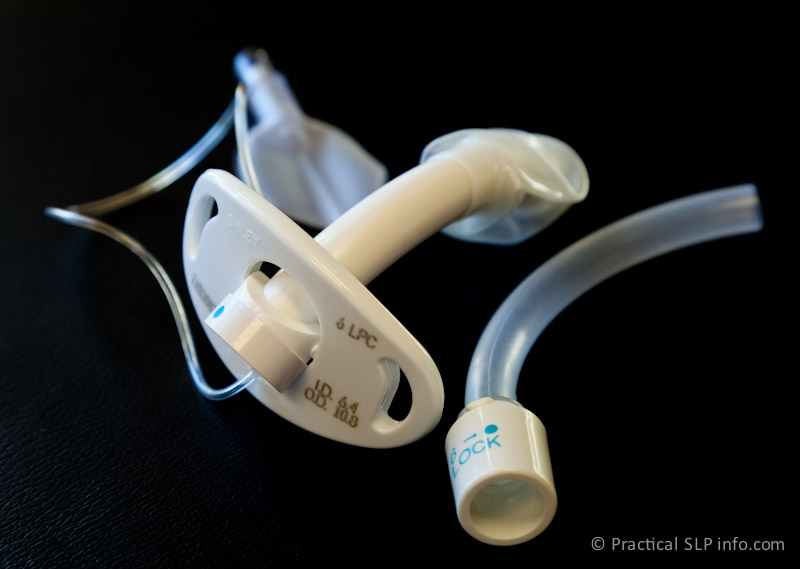A fenestration is a hole in the shaft of the tracheostomy tube, above the curvature, and therefore also above the cuff of a cuffed trach tube. The purpose of a fenestration is to allow for airflow upward and through the vocal cords. Without airflow through the vocal cords, a tracheostomy patient will not be able to produce a voice. For more information regarding voice production, see How a Voice is Produced.
A fenestration is not necessary to be able to talk with a tracheostomy tube, although it will likely improve the loudness and ease of producing a voice. For more information, see Speaking with a Tracheostomy Tube.
Although a fenestrated tube can make speech much easier for tracheostomy patients, it is important to understand that you must use a fenestrated inner cannula as well to achieve the benefits of the fenestration. Standard, non-fenestrated inner cannulas (most common) will block the fenestration, thus blocking the airflow benefits as well.
Although a fenestration can have benefits for speak, there are also some other factors to consider when determining if a fenestrated tube should be used. Because the fenestration is typically aligned along the curved portion of the shaft, there is a potential the fenestration will contact the tracheal wall. If this occurs, the edge of the fenestration may produced contact irritation and trauma to the tracheal lining. In some cases, this can result in the development of a granuloma. A granuloma is a reactive tissue formation (like a blister or callous) that can have a bulbous or ball-like shape. As long as there is continued irritation, the granuloma is likely to stay and even grow.
When granulomas develop in reaction to the fenestration contact, they will generally grow through the fenestration and into the lumen of the tube shaft. As this happens, there may be limitations to airflow, as the granuloma is now obstructing the clear flow of air through the tube. In this way also, the patient achieves no benefit from the fenestration since the space is now blocked by granuloma tissue. The granuloma will also make it difficult for the tube to be removed as it grows through the fenestration.
A fenestration is not necessary to be able to talk with a tracheostomy tube, although it will likely improve the loudness and ease of producing a voice. For more information, see Speaking with a Tracheostomy Tube.
Although a fenestrated tube can make speech much easier for tracheostomy patients, it is important to understand that you must use a fenestrated inner cannula as well to achieve the benefits of the fenestration. Standard, non-fenestrated inner cannulas (most common) will block the fenestration, thus blocking the airflow benefits as well.
Although a fenestration can have benefits for speak, there are also some other factors to consider when determining if a fenestrated tube should be used. Because the fenestration is typically aligned along the curved portion of the shaft, there is a potential the fenestration will contact the tracheal wall. If this occurs, the edge of the fenestration may produced contact irritation and trauma to the tracheal lining. In some cases, this can result in the development of a granuloma. A granuloma is a reactive tissue formation (like a blister or callous) that can have a bulbous or ball-like shape. As long as there is continued irritation, the granuloma is likely to stay and even grow.
When granulomas develop in reaction to the fenestration contact, they will generally grow through the fenestration and into the lumen of the tube shaft. As this happens, there may be limitations to airflow, as the granuloma is now obstructing the clear flow of air through the tube. In this way also, the patient achieves no benefit from the fenestration since the space is now blocked by granuloma tissue. The granuloma will also make it difficult for the tube to be removed as it grows through the fenestration.
_Simple endoscopic examination through the tracheostomy tube will determine
if there is granuloma formation, although there are other indications patients
are able to identify themselves. For
example, if the granuloma is growing through the fenestration, removal and
reinsertion of the inner cannula may become more difficult. There may also be
notable bleeding with inner cannula changes. Granulomas are extremely vascular,
meaning they are filled with a great deal of small, fragile blood vessels.
Because of this, they are very prone to bleeding. When changing an inner
cannula, there should normally be no contact with tracheal tissue. For this
reason, if you notice even small amounts of blood during or after inner cannula
changes, you should mention this to your doctor for further evaluation.
Although granulomas are not worrisome in nature, they can contribute to complications that can be difficult to manage. If you are concerned in this regard, your doctor or SLP staff can examine you further.
Use of a fenestrated tube is generally not recommended when cuff inflation is required to protect the airway from aspiration. Since the fenestration is located above the cuff, saliva and secretions can fall through the fenestration, limiting this benefit of cuff inflation. It is important to remember, however, that a fenestrated tube can have the same benefit in this regard as a non-fenestrated tube, simply by using a non-fenestrated inner cannula.
Your doctor will always determine which tube is the most appropriate for you, but understanding tube principles can help you better manage and maintain your tracheostomy.
Although granulomas are not worrisome in nature, they can contribute to complications that can be difficult to manage. If you are concerned in this regard, your doctor or SLP staff can examine you further.
Use of a fenestrated tube is generally not recommended when cuff inflation is required to protect the airway from aspiration. Since the fenestration is located above the cuff, saliva and secretions can fall through the fenestration, limiting this benefit of cuff inflation. It is important to remember, however, that a fenestrated tube can have the same benefit in this regard as a non-fenestrated tube, simply by using a non-fenestrated inner cannula.
Your doctor will always determine which tube is the most appropriate for you, but understanding tube principles can help you better manage and maintain your tracheostomy.



